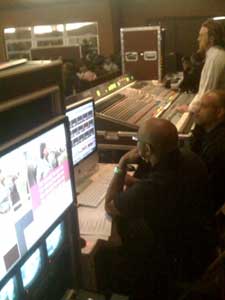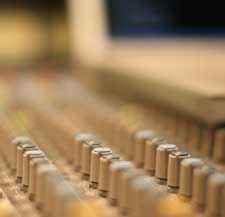Projects, Technology - by Jeff - November 4, 2009 - 08:20 Etc/GMT+5 - Be first to Comment!

Any time of the year, your tech team is busy planning on, preparing for or producing an extra service. Easter and Christmas tend to be the first bigger productions a tech team will have on a schedule, but the calendar is full of events that are outside of the normal weekly worship. Concerts, outreaches, conferences, VBS, holidays, awards, celebrations and facility rentals; each of these events requires additional planning, preparation, equipment, and crew. How can your creative, tech and media teams support these events, make them extraordinary, and yet endure well on the week to week support of the ministry? As a Media Ministry, we’ll define the purpose, put proper time into planning, and then systematically check each medium in place to support the event. Full Story
Excellence in the Arts - by Jeff - September 30, 2009 - 07:56 Etc/GMT+5 - Be first to Comment!

When mixing a large number of instruments and voices the overall sound can get heavy or dense, especially if there are not many parts in the orchestration and everyone is playing / singing the same thing. This is a typical problem we face in churches with large worship teams on the platform and can contribute to the volume level feeling too loud, even when the SPL meter is right where we want it. How can this be prevented? What can be done to fix the mix and bring life back to the music? Full Story
Excellence in the Arts, Media - by Jeff - February 11, 2009 - 15:00 Etc/GMT+5 - 2 Comments
I get questions about our broadcast and recording mixes, and thought I would try to answer some here. Some of these apply to our live mix as well.
“I know we are just hearing the mic’d voices, but even in that a particular voice will stand out strongly above the others, which sometimes is not good.”
There are really a couple issues here.
1) The first problem is when the vocals just aren’t mixed right. This is very evident early during rehearsal where we are slowly dialing everything in a piece at a time, adjusting and re-adjusting. But by the end of rehearsal, or the end of the first song, this should not be a problem – unless
- the sound tech can’t hear the problem (due to room acoustics, monitor system, other noise or issues distracting them such as training or a larger “problem”)
- Someone who was not at rehearsal is singing during the service – this happens often and often takes a while to figure out what is going on and get them dialed in.
- Sometimes the vocals standing out aren’t on a mic. We have had orchestra members singing, very strong choir members caught up in worship, audience members close to audience mics singing out, etc.
2) If the vocals are well mixed, often the person slipping out of key will stand out like a sore thumb. If the vocals have been blended well and they are all singing together, if one person is challenged by the song, they will stick out when they can’t quite get to that note, sounding louder than the rest of the group, even though they have been (and still are) blended in.
3) Sometimes people are just a challenge to keep mixed. We are dealing with 56+ channels of audio, trying to keep up with an ever changing landscape of sound. Theoretically, once everything is mixed, they should stay mixed, but in reality that doesn’t happen at all. Each song, each section of the songs require minor changes in the mix, not to mention changing styles, order of service etc. Throw on top of this challenging people, and they are going to stand out. This includes several who blend well, until we sing a song that totally gets them into worship, and they just start singing out. This includes a couple people who sing very softly if they don’t know the song, very strongly if they do… and that can even change within the song. This includes the person on the praise team who has a lot on his mind, and finds it hard to concentrate and is starring off into space, then snaps back and really sings out. Then add in musicians who can experience similar issues, and the mix can get out of hand. We do our best to ride the mix, but only have so many fingers….
“What are somethings we can do about the mix? ”
Honestly the practice practice practice is the best cure. And that goes for the source (musicians and vocalist) as much as it goes for the actual mixing. The best mixes we get are often things like musicals where the rehearse (and record it) go listen, come back and do it again, re-evaluate, go and listen again and make even more adjustments. This is one huge difference between an album and a live stream. An album they have gone in tweaked, tweaked, and tweaked over and over again till they are happy with it. With a live stream you have one shot. Broadcast is definitely trickier than live because of the encoding, compression, different listening environments, etc. A lot less forgiving than live.
Another problem we face is the mix environment – the better listening / mix environment you can work the mix in, the better it is going to sound in the various sound systems it will be played back on. Currently our audio room is REALLY BAD at this. What sounds good in there can sound terrible in the computer speakers in the other room. Our audio guys typically check the sound in their monitors, in the headphones, in the halls, and at the computer – all four sound a lot different (even though they are all the same mix) and the goal is to make them all sound good – very difficult. Thing about all the different ways people will be listening – everything from mp3 headphones to home stereos, to little computer speakers – all have very different responses and different listening environments, all have to be addressed separately. [we have tried and tried to fix our mix environment, but unfortunately the biggest limiting factor is space, then background noise.]
Then there is the room acoustics in the sanctuary. All the sound bouncing around the room and being picked up by the mics tends to either make it sound airy / hollow or muddy. This is why we try to put the mics as close to the source (instrument or mouth) as possible to minimize the background noise, but our room is really bad when it comes to acoustical environment for the PA and recording. Fixing the acoustics of the room involves tuning the room so it has an even reverberation field across all frequencies (low, mid and high frequency reverberation is consistent), reduce reflections back to stage (cleans up the sound in the mics and would help the musicians and vocalist feel like they could hear themselves better), even out the hot spots / dead spots and provide an environment that is controllable and varies less between full and empty, hot and cold, humid and dry… this is a process that is going to take some time and money.
The garbage in = garbage out principle applies also. Sometimes the problem is what is coming into the system. Recently we were dealing with really bad drum sounds, trying to adjust console eq and mix, when one of the audio techs suggested the drummer try a different kit setup on the electronic drums and that fixed the problem. Maybe some of the instrumentalist need to tune again or a vocalist is just having a bad day. Then occasionally there are those who really need to find a different ministry to serve with, one that matches their God given gifts and talents because singing, playing in the band or mixing sound is not for them.
How often have you heard a live broadcast mix that sounds really good? I would say that we hear bad ones and mediocre ones much more often. Most of what we see on TV or hear on the radio (or online) have been recorded, produced, edited, perfected then broadcast (think Austin City Limits)… what other live music mixes are there out there: Think about half-time concerts at the SuperBowl (and that mix is usually pretty bad). New Years eve? Really can’t think of many other than churches.
“can we put microphones over the congregation to try to capture the congregational singing on the broadcast and recording?”
We have a pair of mics over the congregation. We mix these into the broadcast mix to provide a little more of a live feel for those listening. But sometimes we have to turn them off because they are just making the mix muddy or we have a lot of extra noise close to the mics. There is also the fundamental problem of how slow sound travels, and by the time the sound gets from the speakers / stage to where the audience mics are, it is picked up as a distinct delay. Remember microphones are just the EARS of the sound system, what ever your ears hear when they are at the microphone location, that is pretty much what the mic picks up.
Anywhere in the sanctuary is going to have sound from the PA system, room noise, etc that will become part of the mix when audience mics are used. So typically the audience mics are used to avoid dead air (say while we are waiting for someone to walk up to the pulpit and all the other mics are off), pick up audience reaction (clapping, laughter, a-cappella singing, etc). Once again, better room acoustics would help make audience mics more usable.
But I also like to remind people that there are some laws of physics we are working within, and there is only so much we can do to bend those rules (okay, not bend the rules, just work within the finer points of the rules). There are also principles of psycho-acoustics, audiology, and emotion all at play making a very convoluted, complicated web that is not always easy to decode and implement.

 Stark Raving Solutions and
Stark Raving Solutions and










